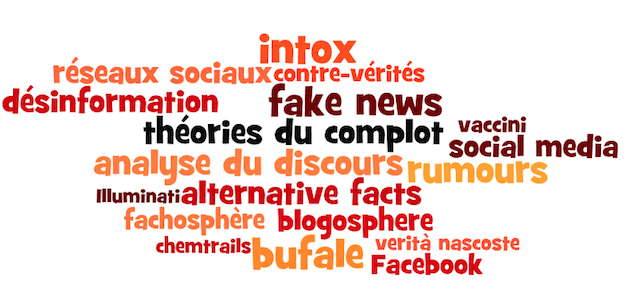Fake news, alternative facts, rumours… Discursive strategies and aims of disinformation
University of Pisa, 4th and 5th October 2018

Call for papers > Call for Papers“[The rumour] is dreary and grey, insidious and underhand. It slips out of hands as the filthy membrane of dead eel.” (Pierre Desproges)
Fake news, rumours, alternative facts… These are just some of the ways in which we refer to the various phenomena that have become commonplace in the so-called “post-truth” era, characterised by a proliferation of sources of information. If it is true that “rumour is as old as the world”, it is also true that widespread of the use of the Internet has contributed to the resurgence in the diffusion of fake news, notably by blogosphere and social media (Heiderich, 2004; Aron & Cognard, 2014; Harbulot, 2016). As such, the Internet would be considered “the ideal medium for rumour” (Froissart, 2002), since it allows anyone to publish and to diffuse a vast array of information, playing on the fears of Internet users. In a climate of general scepticism, where people’s confidence in the establishment and in the political elite is increasingly fragile, fake news infiltrates public debate, by fuelling the success of conspiracy theories, and sometimes expressed through hateful discourse. Controversy surrounding political and/or social issues (rigging elections, terrorist attacks, immigration…) seems to be increasing, while other domains – such as science or technology– are also affected (Doumergue, 2017). The goal seems to be to pollute public debate and destabilise public opinion. An example of this phenomenon would be recent controversies linked to vaccination or the food industry that have proved violent debate on social media and elsewhere. Meanwhile, the dissemination of fake news seems to be widespread in politics: take, for example, the mystification of information carried out by the media in order to obtain public consent (Geng, 1973) or in black rooms, which are services specialising in the circulation of fake news with the aim of discrediting political adversaries. As far as economics is concerned, the spreading of misinformation is a way of unsettling rivals and has therefore become a key element in economic war (Harbulot, 2016). We propose a reflection on the following issues: - How can we define “fake news”, “rumours”, “alternative facts”, etc.? - How do the authors of misinformation establish a controversial counter discourse in opposition to an official, institutionalised, dominant discourse? What are the linguistic and argumentative modalities of this counter discourse? - How do social actors react when faced with presumed disinformation? Is it possible to demystify fake news? What are the linguistic modalities that could be used for this “demystification”, which is, in turn, a counter-speech (debunking falsehoods, reality checks, fact checking sections on websites etc.)? - Which discursive strategies can be used to establish (or re-establish) what is to be presented as the “truth”? - To what extent can the spreading of misinformation be considered a manipulative discourse? What can be done to reveal the rhetorical strategies and implicit speech acts aimed at misleading (misused metaphors, amalgam, fallacious argumentations… Perelman, Tyteca [1958], 1953; Koren 2011, 2012)? The aim of this conference is to analyse misinformation in a linguistic perspective. Contributions can deal with, but are not limited to, the following topics:
Multidisciplinary approaches will be particularly appreciated. Languages of the conference: French, English, Italian. |

